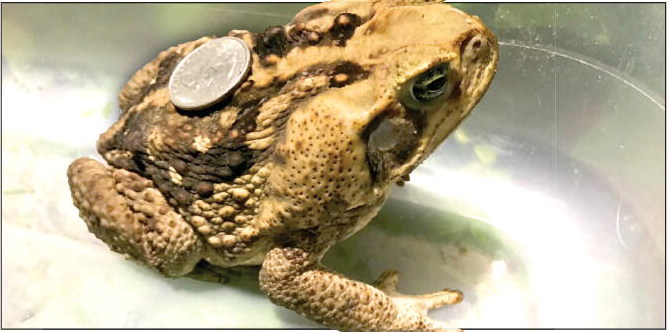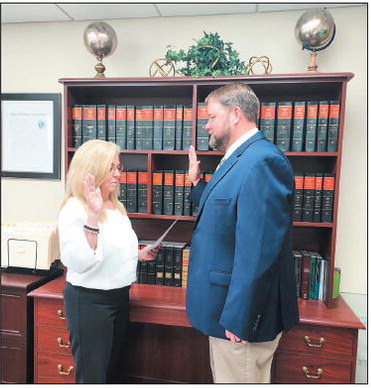Be on the Lookout for Invasive Toxic Toad


A most unwelcome visitor surfaced recently in a Vidalia neighborhood, and wildlife biologists are wondering how the critter got this far north of its usual territory. The cane toad found by a local resident in the yard of his parents’ home is an invasive species — and it’s toxic.
“It definitely got some assistance in getting here,” Georgia Department of Natural Resources Senior Wildlife Biologist Daniel Sollenberger said in a phone interview last week. “What I suspect, or hope, is that it was transported accidentally from a Florida nursery (where the toad is prolific) in the root ball of tree or in a box of oranges,” he said. The wildlife biologist said the Vidalia report is only the second record of a cane toad in Georgia. The first report was from Cam- continued from page
den County. Right now, scientists don’t know if the toad reported in Vidalia is the only toad in the area or if there are more. That’s why it is important that when residents think they have discovered a cane toad, they need to capture it — safely — and call DNR.
“In the next few months, there are not going to be a many toads in yards or gardens, but as it warms up in spring, be on the lookout,” Sollenberger said. He explained that the native Southern toad, which is common throughout the area, can get to be the size of a baseball and might be mistaken for the cane toad. “The Southern toad is the only other large toad that is supposed to be here. If you see a toad the size of your hand, it’s probably not native.”
For those who are brave enough to take a closer look, Southern toads have cranial crests, or fin-like horns between their eyes. Cane toads have a boney ridge that runs around the eyes and onto the nose,” Sollenberger explained. He said native toads have round parotid (poison) glands — yes, native toads are somewhat toxic but not on par with cane toads. “Cane toads have a really big triangular shaped parotid glands that run down to the shoulder,” Sollenberger noted.
This toad is not the one popular with “toad lickers' who unwisely lick toads like the Colorado River toad to get high. “If you were to lick the cane toad, you would get deathly ill. You would not want to handle one and not wash your hands or rub your eyes. These toads are so toxic that most things in the wild don’t mess with them.”
Wildlife biologists are already battling another invasive species, the Tegu continued from page
(a giant lizard native to South America), which has established in Toombs and Tattnall counties. Sollenberger said there are a lot of wet places in southern Toombs County and throughout the area that would favor the cane toad proliferating and getting established.
Sollenberger advised residents if they see what they think is a cane toad, they should capture it and place it in a small container and contact the DNR. Take a photo and send it to Sollenberger’s email address: daniel.sollenberger@ dnr.ga.gov; or call the office at 478-994-1438.
The cane toad is the only amphibian that is regulated as a wild animal. “You have to have a license to possess one in Georgia. Pet stores cannot legally sell these toads in Georgia,” Sollenberger said. The toad found in Vidalia was collected by the Center for Invasive Species and Ecosystem Health that will use it for educational outreach. For more information, check out the University of Georgia Center for Invasive Species and Ecosystem Health Early Detection and Distribution Mapping System, a web-based system for documenting invasive species distribution, at www. EDDMapS.org). Also, the Florida Fish and Wildlife Conservation Commission has extensive information, photos and videos to help identify the cane toad.






